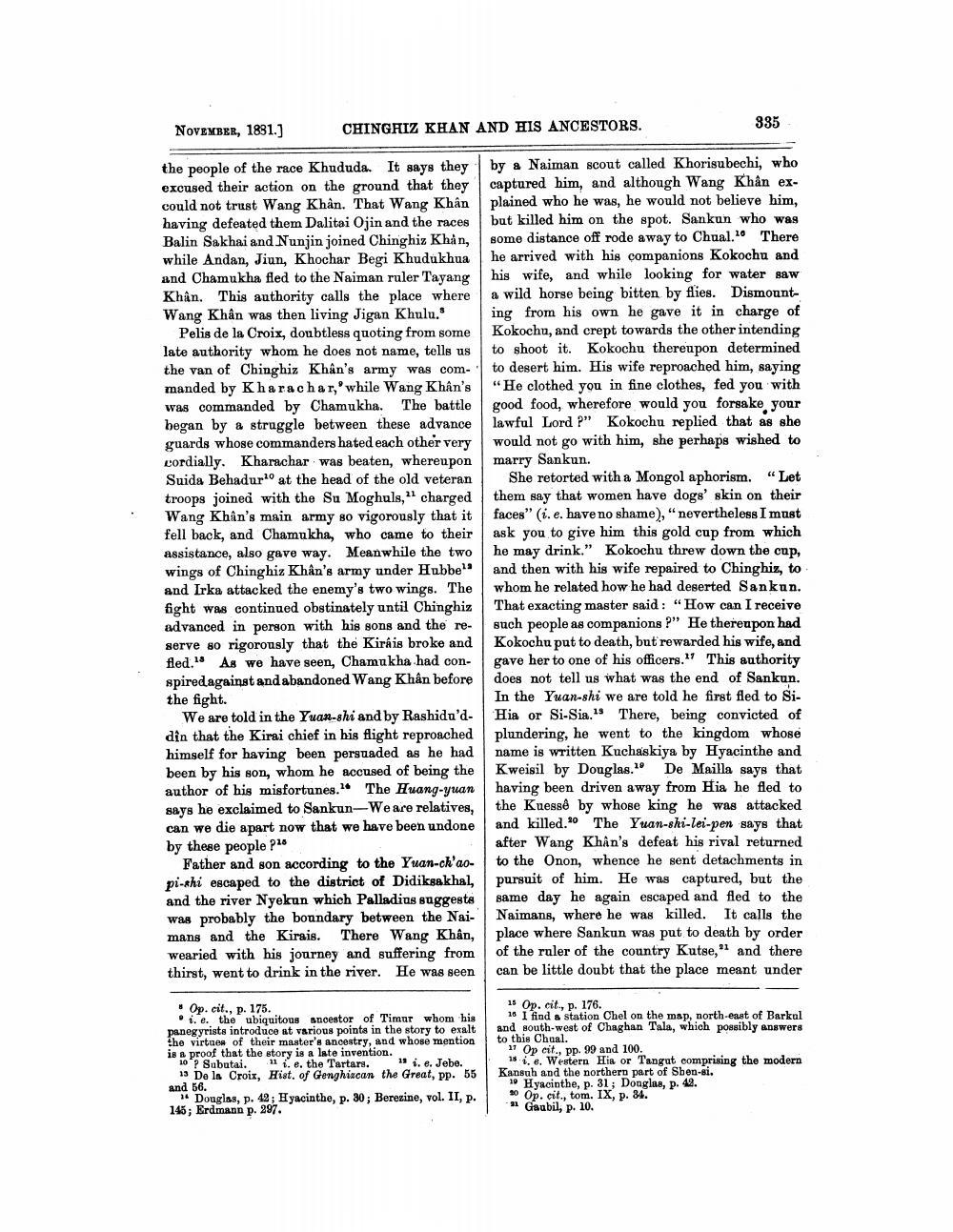________________
CHINGHIZ KHAN AND HIS ANCESTORS.
NOVEMBER, 1881.]
the people of the race Khududa. It says they excused their action on the ground that they could not trust Wang Khân. That Wang Khân having defeated them Dalitai Ojin and the races Balin Sakhai and Nunjin joined Chinghiz Khan, while Andan, Jiun, Khochar Begi Khudukhua and Chamukha fled to the Naiman ruler Tayang Khân. This authority calls the place where Wang Khân was then living Jigan Khulu."
Pelis de la Croix, doubtless quoting from some late authority whom he does not name, tells us the van of Chinghiz Khân's army was commanded by Kharachar,' while Wang Khân's was commanded by Chamukha. The battle began by a struggle between these advance guards whose commanders hated each other very cordially. Kharachar was beaten, whereupon Suida Behaduro at the head of the old veteran troops joined with the Su Moghuls," charged Wang Khan's main army so vigorously that it fell back, and Chamukha, who came to their assistance, also gave way. Meanwhile the two wings of Chinghiz Khân's army under Hubbe1" and Irka attacked the enemy's two wings. The fight was continued obstinately until Chinghiz advanced in person with his sons and the reserve so rigorously that the Kiráis broke and fled. As we have seen, Chamukha had conspired against and abandoned Wang Khân before the fight.
We are told in the Yuan-shi and by Rashidu'ddin that the Kirai chief in his flight reproached himself for having been persuaded as he had been by his son, whom he accused of being the author of his misfortunes. The Huang-yuan says he exclaimed to Sankun-We are relatives, can we die apart now that we have been undone by these people pl
Father and son according to the Yuan-ch'aopi-shi escaped to the district of Didiksakhal, and the river Nyekun which Palladius suggests was probably the boundary between the Nai-" mans and the Kirais. There Wang Khân, wearied with his journey and suffering from thirst, went to drink in the river. He was seen
Opbiquitous ancestor of Timur whom his
cit., p. 175.
panegyrists introduce at various points in the story to exalt. the virtues of their master's ancestry, and whose mention is a proof that the story is a late invention.
10 ? Subutai. 11. e. the Tartars. 1. e. Jebe. 13 De la Croix, Hist. of Genghizcan the Great, pp. 55 and 56.
14 Douglas, p. 42; Hyacinthe, p. 30; Berezine, vol. II, p. 145; Erdmann p. 297.
335
by a Naiman scout called Khorisubechi, who captured him, and although Wang Khân explained who he was, he would not believe him, but killed him on the spot. Sankun who was some distance off rode away to Chual. 10 There he arrived with his companions Kokochu and his wife, and while looking for water saw a wild horse being bitten by flies. Dismounting from his own he gave it in charge of Kokochu, and crept towards the other intending to shoot it. Kokochu thereupon determined to desert him. His wife reproached him, saying "He clothed you in fine clothes, fed you with good food, wherefore would you forsake your lawful Lord ?" Kokochu replied that as she would not go with him, she perhaps wished to marry Sankun.
She retorted with a Mongol aphorism. "Let them say that women have dogs' skin on their faces" (i. e. have no shame), "nevertheless I must ask you to give him this gold cup from which he may drink." Kokochu threw down the cup, and then with his wife repaired to Chinghiz, to whom he related how he had deserted Sankun. That exacting master said: "How can I receive such people as companions?" He thereupon had Kokochu put to death, but rewarded his wife, and gave her to one of his officers." This authority does not tell us what was the end of Sankun. In the Yuan-shi we are told he first fled to SiHia or Si-Sia. There, being convicted of plundering, he went to the kingdom whose name is written Kuchaskiya by Hyacinthe and Kweisil by Douglas.19 De Mailla says that having been driven away from Hia he fled to the Kuesse by whose king he was attacked and killed.20 The Yuan-shi-lei-pen says that after Wang Khân's defeat his rival returned to the Onon, whence he sent detachments in pursuit of him. He was captured, but the same day he again escaped and fled to the Naimans, where he was killed. It calls the place where Sankun was put to death by order of the ruler of the country Kutse," and there can be little doubt that the place meant under
15 Op. cit., p. 176.
18 I find a station Chel on the map, north-east of Barkul and south-west of Chaghan Tala, which possibly answers to this Chual.
17 Op cit., pp. 99 and 100.
15. e. Western Hia or Tangut comprising the modern Kansuh and the northern part of Shen-si.
19 Hyacinthe, p. 31; Donglas, p. 42.
20 Op. cit., tom. IX, p. 34.
1 Gaubil, p. 10.




